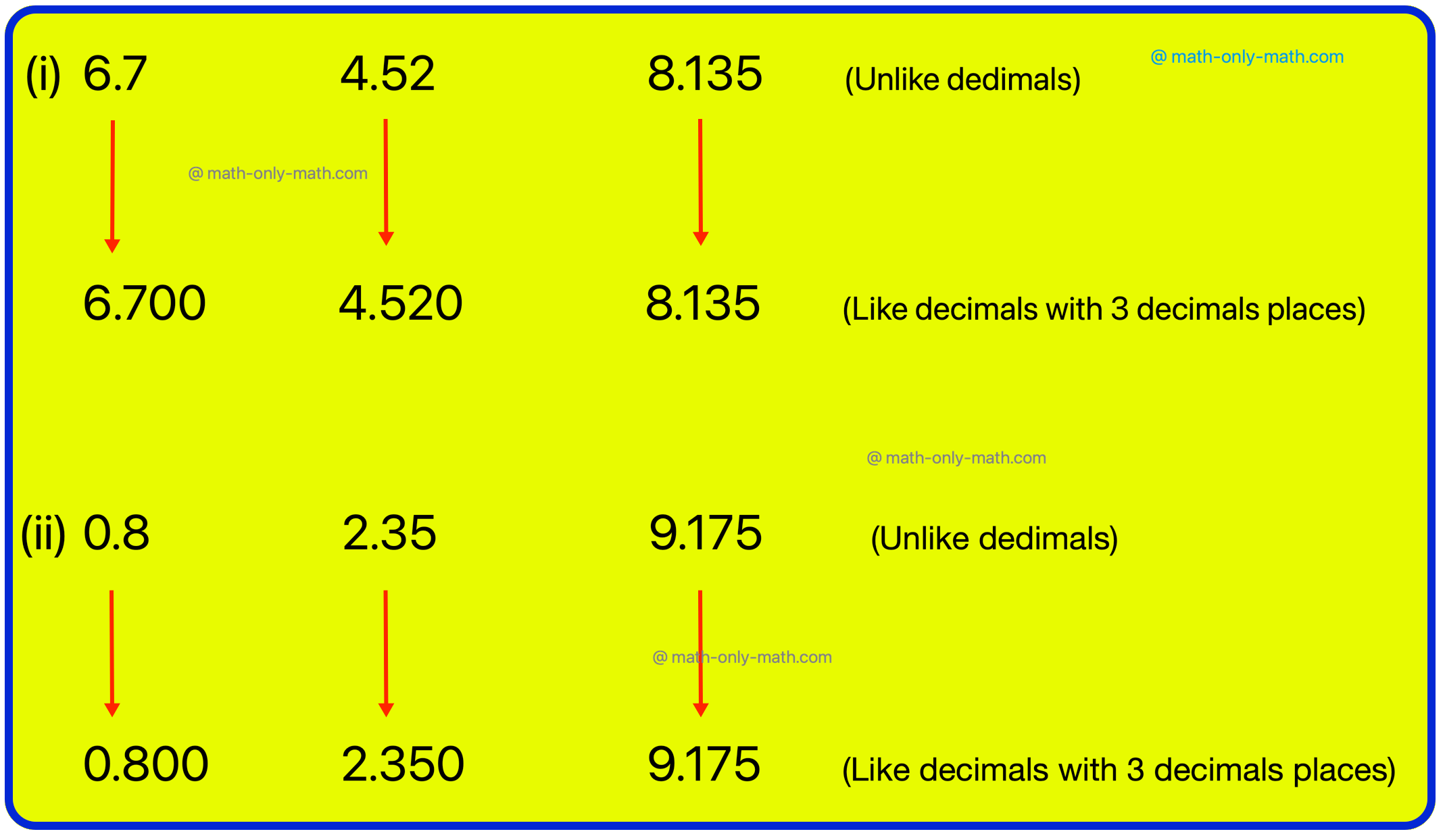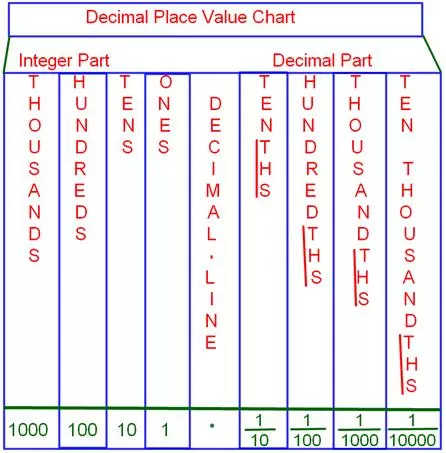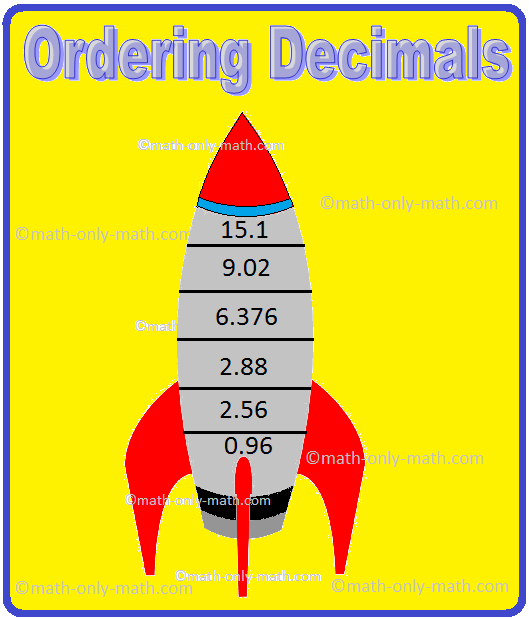Conversion of
Unlike Decimals to Like Decimals
In conversion of unlike decimals to like decimals follow the steps of the method.
Step I: Find the decimal number having the maximum number of decimal places, say (n).
Step II: Now, convert each of the decimal numbers to ‘n’ places of decimals.
Note:
If we put a number of zeros to the extreme right of decimal, the value of the decimal remains the same.
0.8 = 0.80 = 0.800
0.8 = 8/10 and 0.80 = 8Thus to convert unlike decimals to like decimals, we follow the same method.
Converting Unlike Decimals Into Like Decimals:
We can convert unlike decimals into like decimals by adding zeros to the right of decimal point by finding their equivalent decimal.
For Example:
1. Express as a set of like decimals.
(i) 6.7, 4.52, 135
(ii) 0.8, 2.35, 9.175
Solution:
Examples on conversion of unlike decimals
to like decimals:
1. Convert the decimal numbers 5.42, 11.6 and 212.075 into like decimals.
Solution:
We observe that in the given decimals 5.42, 11.6 and 212.075; the maximum number of decimal places is three.
The decimal 212.075 has the maximum number of decimal places, i.e., 3. So, we convert each of the other decimal numbers into the one having three places of decimal.
So, 5.42 is written as 5.420,
11.6 is written as 11.600
212.075 is already having three decimal places.
Therefore, 5.420, 11.600 and 212.075 are expressed as like decimals.
2. Covert the following unlike decimals 1.72, 26.361, 3.35 and 0.9 into like decimals.
Solution:
We observe that in the given decimals 1.72, 26.361, 3.35 and 0.9 the maximum number of decimal places is three.
The decimal 26.361 has the maximum number of decimal places, i.e., 3. So, we convert each of the other decimal numbers into the one having three places of decimal.
So, 1.72 is written as 1.720,
26.361 is already having three decimal places,
3.35 is written as 3.350,
0.9 is written as 0.900
Therefore, all the decimal numbers 1.720, 26.361, 3.350 and 0.900 are converted to like decimals.
3. (i) Are the following decimals 9.5, 18.235 and 20.0254 are like or unlike decimals.
(ii) If, the decimals are unlike then convert it into like decimals.
Solution:
(i) The following decimals 9.5, 18.235 and 20.0254 are unlike decimals.
(ii) We observe that in the given decimals 9.5, 18.235 and 20.0254; the maximum number of decimal places is four.
The decimal 20.0254 has the maximum number of decimal places, i.e., 4. So, we convert each of the other decimal numbers into the one having four places of decimal.
So, 9.5 is written as 9.5000,
18.235 is written as 18.2350
20.0254 is already having four decimal places.
Therefore, 9.5000, 18.2350 and 20.0254 are the conversion to like decimals.
Worksheet on Change Unlike Decimals to Like Decimals:
1. Convert each of the following groups into like decimals:
(i) 9.5, 6.73
(ii) 0.36, 13.5
(iii) 39.01, 4.5
(iv) 24.5, 195, 69.16
(v) 0.8, 7.02, 0.656
(vi) 7.134, 0.87, 15.2
Answer:
1. (i) 9.50, 6.73
(ii) 0.36, 13.50
(iii) 39.01, 4.50
(iv) 24.50, 195.00, 69.16
(v) 0.800, 7.020, 0.656
(vi) 7.134, 0.870, 15.200
● Related Concept
● Decimals
● Conversion of Unlike Decimals to Like Decimals
● Decimal and Fractional Expansion
● Converting Decimals to Fractions
● Converting Fractions to Decimals
● H.C.F. and L.C.M. of Decimals
● Repeating or Recurring Decimal
● BODMAS/PEMDAS Rules - Involving Decimals
● PEMDAS Rules - Involving Integers
● PEMDAS Rules - Involving Decimals
● BODMAS Rules - Involving Integers
● Conversion of Pure Recurring Decimal into Vulgar Fraction
● Conversion of Mixed Recurring Decimals into Vulgar Fractions
● Rounding Decimals to the Nearest Whole Number
● Rounding Decimals to the Nearest Tenths
● Rounding Decimals to the Nearest Hundredths
● Simplify Decimals Involving Addition and Subtraction Decimals
● Multiplying Decimal by a Decimal Number
● Multiplying Decimal by a Whole Number
● Dividing Decimal by a Whole Number
● Dividing Decimal by a Decimal Number
From Conversion of Unlike Decimals to Like Decimals to
Didn't find what you were looking for? Or want to know more information about Math Only Math. Use this Google Search to find what you need.
Recent Articles
-
Missing Numbers up to 10 | Worksheets on Missing Numbers up to 10
Apr 18, 25 04:53 PM
Printable worksheets on missing numbers up to 10 help the kids to practice counting of the numbers. -
Ordering Decimals | Comparing Decimals | Ascending & Descending Order
Apr 18, 25 01:49 PM
In ordering decimals we will learn how to compare two or more decimals. (i) Convert each of them as like decimals. (ii) Compare these decimals just as we compare two whole numbers ignoring -
Worksheet on Comparing and Ordering Decimals |Arranging Decimals
Apr 18, 25 01:14 PM
Practice different types of math questions given in the worksheet on comparing and ordering decimals. This worksheet contains questions mainly related to compare decimals and then place the decimals i… -
Decimal Place Value Chart |Tenths Place |Hundredths Place |Thousandths
Apr 18, 25 12:58 PM
Decimal place value chart are discussed here: The first place after the decimal is got by dividing the number by 10; it is called the tenths place. -
Conversion of a Decimal Fraction into a Fractional Number | Decimals
Apr 18, 25 12:28 PM
We will discuss here about the working rule for the conversion of a decimal fraction into a fractional number. The rules of converting decimal number to fraction are


















New! Comments
Have your say about what you just read! Leave me a comment in the box below. Ask a Question or Answer a Question.